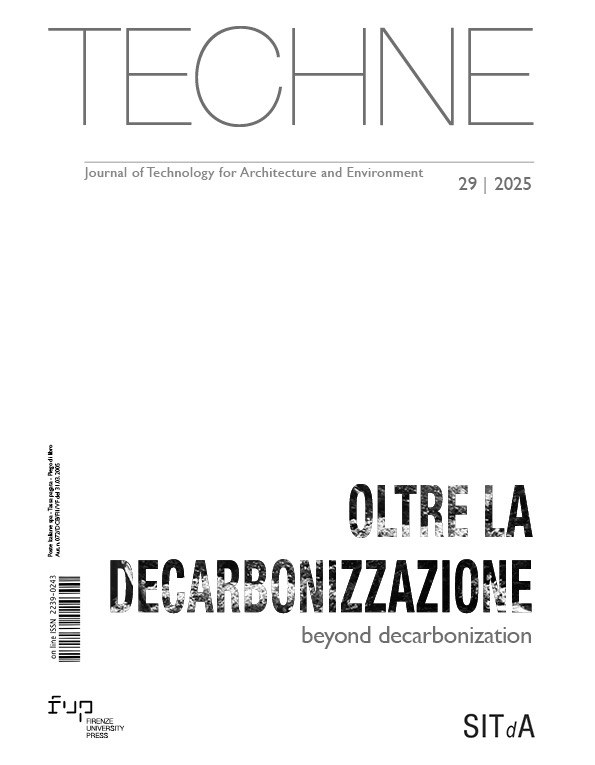Published 2025-07-31
Keywords
- biogenic materials,
- whole life carbon,
- climate neutrality,
- prefabrication,
- sustainable architecture
How to Cite
Copyright (c) 2025 Francesca Thiebat, Fiamma Morselli

This work is licensed under a Creative Commons Attribution 4.0 International License.
Abstract
This contribution highlights the need to reflect on the environmental, cultural, and social value of biogenic construction materials and their role in the roadmap towards climate neutrality. Based on a mapping of European case studies, the essay investigates the diffusion of biogenic materials in architecture, questioning whether their use is limited to experimental cases or if it can be at the base of a decarbonisation strategy. The analysis conducted reveals the urgency of adopting technologies and practices that promote the diffusion and scalability of biogenic materials to respond to energy and environmental regulations, as well as to contribute effectively and sustainably to the demand for net-positive materials, as alternatives to conventional ones.
This contribution highlights the need to reflect on the environmental, cultural, and social value of biogenic construction materials and their role in the roadmap towards climate neutrality. Based on a mapping of European case studies, the essay investigates the diffusion of biogenic materials in architecture, questioning whether their use is limited to experimental cases or if it can be at the base of a decarbonization strategy. The analysis conducted reveals the urgency of adopting technologies and practices that promote the diffusion and scalability of biogenic materials to respond, on the one hand, to energy and environmental regulations and, on the other hand, to contribute effectively and economically sustainably to the demand for net-positive materials, as alternatives to conventional ones.
Downloads
References
- Andreotti, J. and Giordano, R. (2024) Strumenti per la decarbonizzazione: Valutazione della Whole Life Carbon (WLC) e della Circular Economy (EC) di un manufatto edilizio. GBC Italia. Available at: https://gbcitalia.org/wp-content/uploads/2024/11/Strumenti-per-la-decarbonizzazione_Valutazione-della-Whole-Life-Carbon-WLC-e-della-Circular-Economy-CE-di-un-manufatto-edilizio.pdf.
- Angelucci, F. and Di Sivo, M. (2019) “Designing for co-evolution”, TECHNE – Journal of Technology for Architecture and Environment, pp. 120–127. Available at: https://doi.org/10.13128/TECHNE-7518.
- Brunner, P.H. (2011) “Urban mining: A contribution to reindustrializing the city”, Journal of Industrial Ecology, 15, pp. 339–341. Available at: https://doi.org/10.1111/j.1530-9290.2011.00345.x. DOI: https://doi.org/10.1111/j.1530-9290.2011.00345.x
- Carcassi, O.B., Habert, G., Malighetti, L.E. and Pittau, F. (2022) “Material diets for climate-neutral construction”, Environmental Science & Technology, 56(8), pp. 5213–5223. Available at: https://doi.org/10.1021/acs.est.1c05895. DOI: https://doi.org/10.1021/acs.est.1c05895
- Carcassi, O.B., Paoletti, I. and Malighetti, L.E. (2021) “Reasoned catalogue of biogenic products in Europe: An anticipatory vision between technical potentials and availability”, TECHNE – Journal of Technology for Architecture and Environment, pp. 63–70. Available at: https://doi.org/10.36253/techne-10578. DOI: https://doi.org/10.36253/techne-10578
- Churkina, G., Organschi, A., Reyer, C.P.O., Ruff, A., Vinke, K., Liu, Z., Reck, B.K., Graedel, T.E. and Schellnhuber, H.J. (2020) “Buildings as a global carbon sink”, Nature Sustainability, 3(4), pp. 269–276. Available at: https://doi.org/10.1038/s41893-019-0462-4. DOI: https://doi.org/10.1038/s41893-019-0462-4
- Eisenstein, C. (2016) “Grief and carbon reductionism”. Essay. Available at: https://charleseisenstein.org/essay/grief-and-carbon-reductionism/.
- European Committee for Standardisation (2016) EN 16575: Bio-based products – Vocabulary.
- Fullerton, J. (2015) Regenerative capitalism: How universal principles and patterns will shape our new economy. Capital Institute. Available at: http://capitalinstitute.org/wp-content/uploads/2015/04/2015-Regenerative-Capitalism-4-20-15-final.pdf.
- Galimshina, A., Moustapha, M., Hollberg, A., Lasvaux, S., Sudret, B. and Habert, G. (2024) “Strategies for robust renovation of residential buildings in Switzerland”, Nature Communications, 15(1). Available at: https://doi.org/10.1038/s41467-024-46305-9. DOI: https://doi.org/10.1038/s41467-024-46305-9
- Göswein, V., Arehart, J., Phan-huy, C., Pomponi, F. and Habert, G. (2022) “Barriers and opportunities of fast-growing biobased material use in buildings”, Buildings and Cities, 3(1), pp. 745–755. Available at: https://doi.org/10.5334/bc.254. DOI: https://doi.org/10.5334/bc.254
- Göswein, V., Reichmann, J., Habert, G. and Pittau, F. (2021) “Land availability in Europe for a radical shift toward bio-based construction”, Sustainable Cities and Society, 70, 102929. Available at: https://doi.org/10.1016/j.scs.2021.102929. DOI: https://doi.org/10.1016/j.scs.2021.102929
- Ichioka, S. and Pawlyn, M. (2021) Flourish: Design paradigms for our planetary emergency. Triarchy Press.
- IEA EBC (n.d.) Annex 89 – Ways to implement net-zero whole life carbon buildings.
- Jain, Y. (2021) “Regenerative economies: A new approach towards sustainability”, in W. Leal Filho, A.M. Azul, L. Brandli, A.L. Salvia, P.G. Özuyar and T. Wall (eds.) No poverty. Springer International Publishing, pp. 1–11. Available at: https://doi.org/10.1007/978-3-319-69625-6_80-1. DOI: https://doi.org/10.1007/978-3-319-69625-6_80-1
- Jones, D. and Brischke, C. (2017) Performance of bio-based building materials. Woodhead Publishing. DOI: https://doi.org/10.1016/B978-0-08-100982-6.00001-X
- Lewis, P., Tsurumaki, M. and Lewis, D.J. (2022) Manual of biogenic house sections. Oro Editions – Publishers of Architecture, Art, and Design.
- Mang, P. (2016) Regenerative development and design: A framework for evolving sustainability. DOI: https://doi.org/10.1002/9781119149699
- Pittau, F., Krause, F., Lumia, G. and Habert, G. (2018) “Fast-growing bio-based materials as an opportunity for storing carbon in exterior walls”, Building and Environment, 129, pp. 117–129. https://doi.org/10.1016/j.buildenv.2017.12.006. DOI: https://doi.org/10.1016/j.buildenv.2017.12.006
- Pomponi, F., Hart, J., Arehart, J.H. and D’Amico, B. (2020) “Buildings as a global carbon sink? A reality check on feasibility limits”, One Earth, 3(2), pp. 157–161. Available at: https://doi.org/10.1016/j.oneear.2020.07.018. DOI: https://doi.org/10.1016/j.oneear.2020.07.018
- Ruta, M.F., Pittau, F. and Masera, G. (2024) “Towards zero-carbon buildings: Challenges and opportunities from reversing the material pyramid”, Sustainability, 16(11), 4454. Available at: https://doi.org/10.3390/su16114454. DOI: https://doi.org/10.3390/su16114454
- Stern, E., Walther, R. and Rager, M. (2020) Le tour de France des maisons écologiques. Alternatives – Grand format – Librairie Gallimard PARIS.
- Sutkowska, M., Stefańska, A., Vaverkova, M.D., Dixit, S. and Thakur, A. (2024) “Recent advances in prefabrication techniques for biobased materials towards a low-carbon future: From modules to sustainability”, Journal of Building Engineering, 91, art. no. 109558. Available at: https://doi.org/10.1016/j.jobe.2024.109558. DOI: https://doi.org/10.1016/j.jobe.2024.109558
- Wahl, D.C. (2016) Designing regenerative cultures. Triarchy Press.






